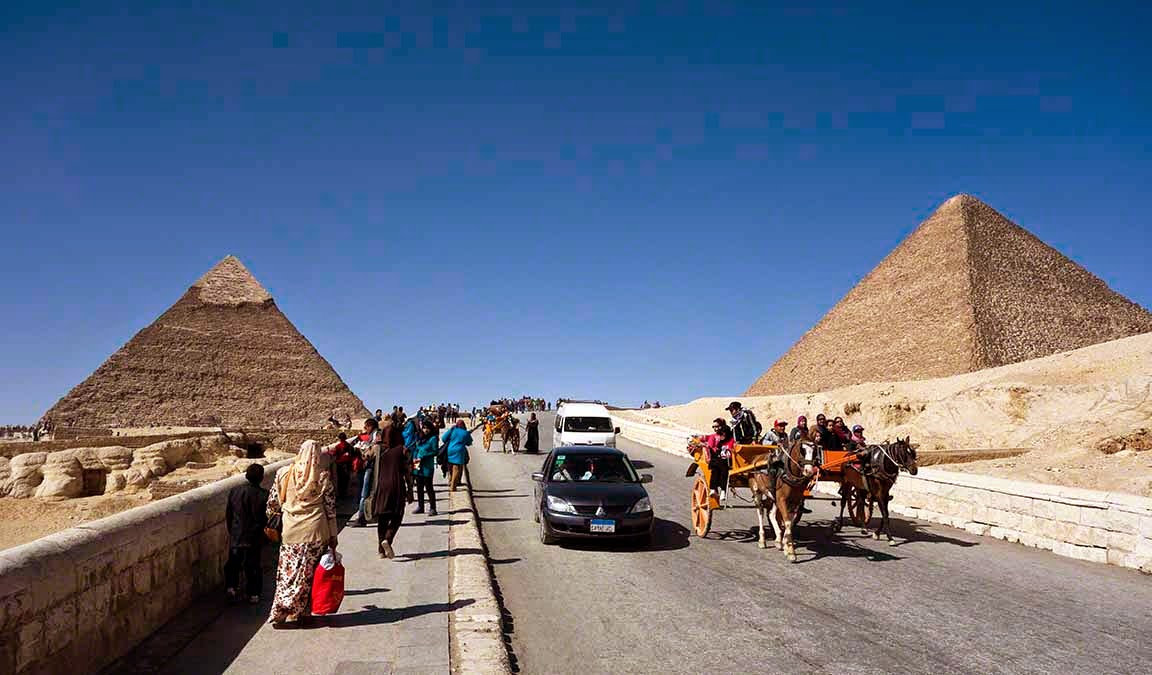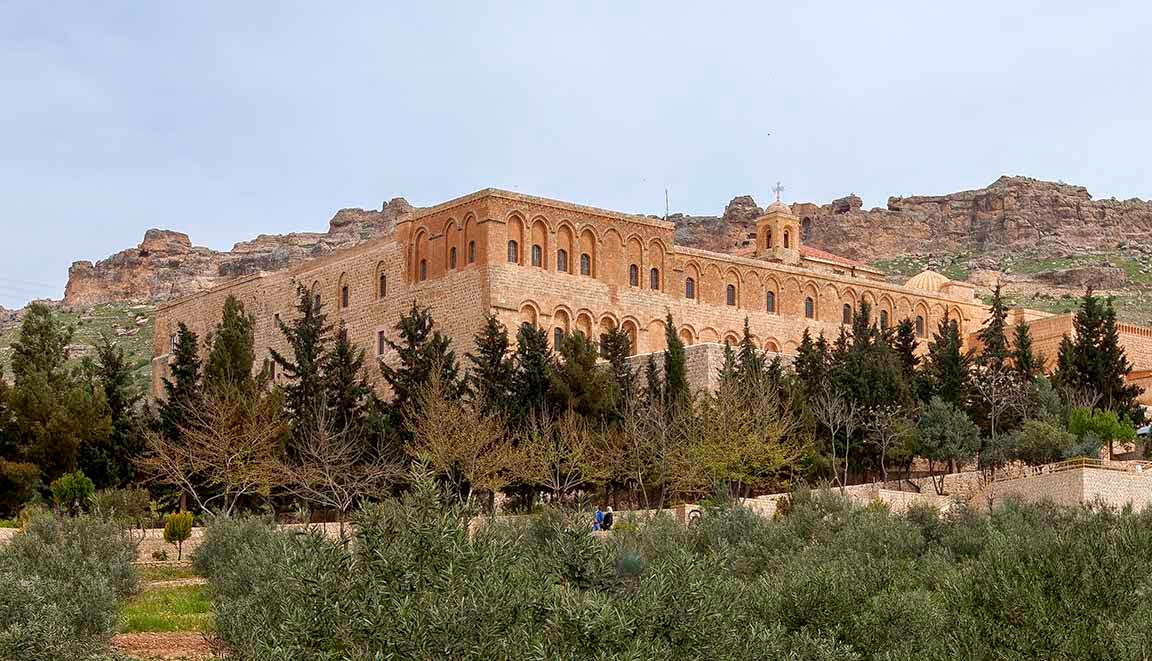Egypt | Giza | Khufu Pyramid
From The Spinx I wandered up the road to the Pyramid of Khufu, also known as Pyramid of Cheops. This is the largest of the three big Giza Pyramids. Although the grounds were nearly deserted when I entered at 8:00 a.m.—opening time—a considerable crowd has accumulated while I was admiring the Spinx. Most of them appear to be Egyptians. Many have hired horse buggies to haul them around the pyramids. The road leading up to the Khufu Pyramid does not look that steep, but the horses are having a hard time negotiating it. They are shod, and their steel horseshoes keep slipping on the asphalt surface of the road. As I watch two horses slip and fall to their knees. Obviously they are used to this, since they very quickly jump up and resume pulling. One horse, pulling a buggy with a family of Egyptians—father, mother, and three small children—refuses to go up the hill. It tries to turn and head back down, but the driver, who is walking along side, starts whacking it with a cane and it very reluctantly turns uphill. It slips and falls to its knees. Bounding up very quickly, it then turns and attempts again to go downhill, precipitously whipping around the buggy. The driver hauls on the reins and whacks it with a cane, finally getting it turned around. It takes a few steps uphill, but then turns yet again and attempts to lunge downhill. All the while the buggy is being whipped back and forth. The family looks scared. One of the little girls starts screaming. For the moment it looks like the driver might lose control completely and the horse will take off downhill at a gallop, quite possibly upsetting the buggy. But the driver shortens the reins and administers a series of solid whacks with his cane. The horse had probably been through all this before and knows that in the end it must bow to the inevitable. It puts its head down and slowly, carefully plods its way uphill. One imagines the pyramids were built this way.
The road does not look so steep in this photo, but horses had trouble negotiating it (click on photos for enlargements).
Moving on from this spectacle, I proceed to the base of the Khufu Pyramid. Like millions of other tourists who have stood here I cannot help but wonder, “What in the name of all that’s holy were they thinking?” I mean, seriously, this is one badass pile of rocks.
The pyramid was built as a tomb for the Fourth Dynasty Pharaoh Khufu. It was probably built over a twenty-year period ending in about 2560 B.C. Thus it has stood here roughly 4570-some odd years. It was originally 481 feet high, and for almost 4000 years it was the tallest manmade structure on earth. It is now missing its capstone and stands around 455 feet high. Each side of the pyramid is 756 feet long. An estimated 2,300,000 blocks of stone was used in its construction. If the Khufu pyramid was built in twenty years, as suggested, then the builders would have had to put in place twelve blocks of stone an hour, 24/7/365 for the entire twenty years. Put differently, they would have had to install 800 tons of blocks every day, seven days a week, fifty-two weeks a year for twenty years.
On the other hand, it could have been Built By Aliens using anti-gravitation devices to float to the blocks into place. Or by the Mysterious Nephilim, the Giants of the Old Testament, spawn of Fallen Angels who could not resist mating with human women. Or maybe it was built by a previous incarnation of Donald Trump. Or by the spawn of Donald Trump’s previous incarnation and Fallen Angels. Or by the spawn of Fallen Angels and Snoop Dog. Tupac Shakur may have been involved, hence his assassination (by the Nephilim?) on September 7, 1996, in Las Vegas, Nevada, home of the Luxor Hotel, which features its very own pyramid. The pyramids seem to invite speculation.
Frontal view of the Khufu Pyramid
Another view of the Khufu Pyramid
Another view of the Khufu Pyramid
Another view of the Khufu Pyramid
The Khufu Pyramid was once completely covered with casing stones of highly polished white limestone. In 1303 A.D. a huge earthquake shook off many of the casing stones. These were carted away and used as building material for mosques and other buildings in Cairo. What remained were used by Muhammad Ali Pasha to build a mosque in the nineteenth century. The pyramid we see today is thus the core of the original pyramid. It must have been a dazzling sight indeed when faced with gleaming white limestone.
Some of the few original casing stones that remain
Another view of the Khufu Pyramid.
People are climbing to the current day entrance to the pyramid, known as the Robber’s Tunnel. It was created by Abbasid Caliph al Mamun in the 820s A.D. His workmen used a battering ram to punch a hole through to the existing corridors within the pyramid. Presumably they were looking for treasure. It now costs 200 Egyptian pounds ($26.38) to enter the interior of the pyramid, and several people I talked to said it was not worth it. So I demurred. Maybe next time.
Another view of the Khufu Pyramid
Today it is not possible to climb to the top of the pyramid. Once, however, an ascent was a standard part of the Great Pyramid tour. In 1873 forty-two year old English writer and gadabout Amelia Edwards made the climb and described it in her book A Thousand Miles Up The Nile. We must rely on her for a description of the view from the top:
The ascent [to the pyramid summit] is extremely easy. Rugged and huge as are the blocks, there is scarcely one upon which it is not possible to find a half-way rest for the toe of one's boot, so as to divide the distance. With the help of three Arabs, nothing can well be less fatiguing. As for the men, they are helpful and courteous, and as clever as possible; and coax one on from block to block in all the languages of Europe. “Pazienza, signora! Allez doncement—all serene! We half-way now—dem halben-weg, fräulein. Ne vous pressezpas, mademoiselle. Chi va sano, va lontano. Six step more, and ecco la cimca!” “You should add the other half of the proverb, amici,” said I. “Chi va forte, va alla My Arabs had never heard this before, and were delighted with it. They repeated it again and again, and committed it to memory with great satisfaction. I asked them why they did not cut steps in the blocks, so as to make the ascent easier for ladies. The answer was ready and honest. “No, no, mademoiselle! Arab very stupid to do that. If Arab makes steps, howadji goes up alone. No more want Arab man to help him up, and Arab man earn no more dollars!”
They offered to sing “Yankee Doodle” when we reached the top; then, finding we were English, shouted “God save the queen!” and told us that the Prince of Wales had given £40 to the pyramid Arabs when he came here with the princess two years before; which, however, we took the liberty to doubt. The space on the top of the great pyramid is said to be thirty feet square. It is not, as I had expected, a level platform. Some blocks of the next tier remain, and two or three of the tier next above that; so making pleasant seats and shady corners. What struck us most on reaching the top was the startling nearness, to all appearance, of the second pyramid. It seemed to rise up beside us like a mountain; yet so close, that I fancied I could almost touch it by putting out my hand. Every detail of the surface, every crack and party-coloured stain in the shining stucco that yet clings about the apex, was distinctly visible. The view from this place is immense. The country is so flat, the atmosphere so clear, the standpoint so isolated, that one really sees more and sees farther than from many a mountain summit of ten or twelve thousand feet. The ground lies, as it were, immediately under one; and the great Necropolis is seen as in a ground-plan.
The effect must, I imagine, be exactly like the effect of a landscape seen from a balloon. Without ascending the pyramid, it is certainly not possible to form a clear notion of the way in which this great burial-field is laid out. We see from this point how each royal pyramid is surrounded by its quadrangle of lesser tombs, some in the form of small pyramids, others partly rock-cut, partly built of massive slabs, like the roofing-stones of the temples. We see how Khufu and Khafra and Menkara lay, each under his mountain of stone, with his family and his nobles around him. We see the great causeways which moved Herodotus to such wonder, and along which the giant stones were brought. Recognizing how clearly the place is a great cemetery, one marvels at the ingenious theories which turn the pyramids into astronomical observatories, and abstruse standards of measurement. They are the grandest graves in all the world—and they are nothing more.
Another view of the Khufu Pyramid
There are signs everywhere telling people not to climb on the pyramids, but boys will be boys (actually there were quite a few girls too) and they could just not resist the urge to ascend the rocks. Security guards were forever shouting at the miscreants to get down, but the moment their heads were turned the kids clambered back up again. Of course all the climbers were constantly taking selfies on their mobile phones, using the stones of the pyramid as a backdrop.
Tomb—I think—near the Khufu Pyramid
Tomb—I think—near the Khufu Pyramid
These are the only examples of hieroglyphics I saw in the area of the pyramids.
School girls from the nearby city of Sakkara on a class excursion to the Pyramids. They asked me to take their photo and I could hardly refuse. The second one from the left, in the red sleeves, was the only one who spoke English, and she proved to be quite the chatterbox.
For the classic, if admittedly now dated, study of the pyramids of Giza see W. M. Flinders Petrie’s The Pyramids And Temples Of Gizeh.
















